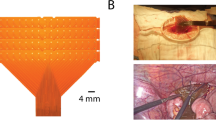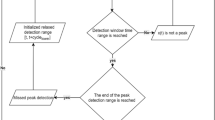Abstract
We present a novel, fully-automated gastrointestinal spike burst detection algorithm. Following pre-processing with SALPA (Wagenaar and Potter, J. Neurosci. Methods 120:113–120, 2002) and a Savitzky–Golay filter to remove unwanted low and high frequency components, candidate spike waveforms are detected utilizing the non-linear energy operator. Candidate waveforms are classified as spikes or artifact by a support vector machine. The new method achieves highly satisfactory performance with >90% sensitivity and positive prediction value. We also demonstrate an application of the new method to detect changes in spike rate and spatial propagation patterns upon induction of mesenteric ischemia in the small intestine. Spike rates were observed to transiently increase 10–20 fold for a duration of ≈600 s, relative to baseline conditions. In ischemic conditions, spike activity propagation patterns included retrograde-longitudinal wavefronts with occasional spontaneous conduction blocks, as well as self-terminating concentric-circumferential wavefronts. Longitudinal and circumferential velocities were 6.8–8.0 cm/s and 18.7 cm/s, respectively.







Similar content being viewed by others
References
Angeli, T. R., G. O’Grady, N. Paskaranandavadivel, J. C. Erickson, P. Du, A. J. Pullan, I. P. Bissett, and L. K. Cheng. Experimental and automated analysis techniques for high-resolution electrical mapping of small intestine slow wave activity. J. Neurogastroenterol. Motil. 19(2):179–191, 2013.
Bozler, E. The relation of the action potentials to mechanical activity in intestinal muscle. Am. J. Physiol. 146:496–501, 1946.
Brookes, S., B. Chen, M. Costa, and C. Humphreys. Initiation of peristalsis by circumferential stretch of flat sheets of guinea-pig ileum. J. Physiol. 516:525–538, 1999.
Cabot, R., and S. Kohatsu. The effects of ischemia on the electrical and contractile activities of the canine small intestine. Am. J. Surg. 136:242–246, 1978.
Chou, C. Relationship between intestinal blood flow and motility. Annu. Rev. Phys. 44:29–42, 1982.
Cortes, C., and V. Vapnik. Support-vector networks. Mach. Learn. 20:273–297, 1995.
Du, P., G. O’Grady, J. Egbuji, W. Lammers, D. Budgett, P. Nielsen, J. Windsor, A. Pullan, and L. Cheng. High-resolution mapping of in vivo gastrointestinal slow wave activity using flexible printed circuit board electrodes: methodology and validation. Ann. Biomed. Eng. 37:839–846, 2009.
Egbuji, J., G. O’Grady, P. Du, L. Cheng, W. Lammers, J. Windsor, and A. Pullan. Origin, propagation and regional characteristics of porcine gastric slow wave activity determined by high-resolution mapping. Neurogastroenterol. Motil. 22:e292–e300, 2010.
Erickson, J., G. O’Grady, P. Du, J. Egbuji, A. Pullan, and L. Cheng. Automated gastric slow wave cycle partitioning and visualization fo high-resolution activation time maps. Ann. Biomed. Eng. 39:469–483, 2011.
Erickson, J., G. O’Grady, P. Du, C. Obioha, W. Qiao, W. Richards, L. Bradshaw, A. Pullan, and L. Cheng. Falling-edge, variable threshold (FEVT) method for the automated detection of gastric slow wave events in high-resolution serosal electrode recordings. Ann. Biomed. Eng. 38:1511–1529, 2010.
Faezipour, M., T. Tiwari, A. Saeed, M. Nourani, and L. Tamil. Wavelet-based denoising and beat detection of ecg signal. In: IEEE Life Science Systems and Applications Workshop, 2009, pp. 100–103.
Fleckenstein, P., and A. Øigaard. Electrical spike activity in the human small intestine. Digest. Dis. Sci. 23:776–780, 1978.
Gonella, J. Modifications of electrical activity of the rabbit duodenum longitudinal muscle after contractions of the circular muscle. Digest. Dis. Sci. 17:327–332, 1972.
Groh, W., I. Takahashi, S. Sarna, W. Dodds, and W. Hogan. Computerized analysis of spike-burst activity of the upper gastrointestinal tract. Digest. Dis. Sci. 29:422–426, 1984.
Hennig, G., M. Costa, B. Chen, and S. Brookes. Quantitative analysis of peristalsis in the guinea-pig small intestine using spatio-temporal maps. J. Physiol. 517:575–590, 1999.
Hsu, C., C. Chang, C. Lin, et al. A Practical Guide to Support Vector Classification, Department of Computer Science, National Taiwan University, 2003.
Huizinga, J., and W. Lammers. Gut peristalsis is governed by a multitude of cooperating mechanisms. Am. J. Physiol. Gastrointest. Liver Physiol. 296:G1–G8, 2009.
Kaiser, J. Some useful properties of teager’s energy operators. In: 1993 IEEE International Conference on Acoustics, Speech, and Signal Processing, ICASSP-93, Vol. 3, 1993, pp. 149–152.
Kim, K.,and S. Kim. Neural spike sorting under nearly 0-db signal-to-noise ratio using nonlinear energy operator and artificial neural-network classifier. IEEE Trans. Biomed. Eng. 47:1406–1411, 2000.
Lammers, W., A. al Kais, S. Singh, K. Arafat, and T. elSharkawy. Multielectrode mapping of slow-wave activity in the isolated rabbit duodenum. J. Appl. Physiol. 74:1454–1461, 1993.
Lammers, W., B. Michiels, J. Voeten, L. VerDonck, and J. Schuurkes. Mapping slow waves and spikes in chronically instrumented conscious dogs: automated on-line electrogram analysis. Med. Biol. Eng. Comput. 46:121–129, 2008.
Lammers, W., and J. Slack. Of slow waves and spike patches. Physiology 16:138–144, 2001.
Lammers, W., B. Stephen, and S. Karam. Functional reentry and circus movement arrhythmias in the small intestine of normal and diabetic rats. Am. J. Physiol. Gastrointest. Liver Physiol. 302:G684–G689, 2012.
Lammers, W., L. VerDonck, J. Schuurkes, and B. Stephen. Longitudinal and circumferential spike patches in the canine small intestine in vivo. Am. J. Physiol. Gastrointest. Liver Physiol. 285:G1014–G1027, 2003.
Lammers, W. J., B. Stephen, and J. R. Slack. Similarities and differences in the propagation of slow waves and peristaltic waves. Am. J. Physiol. Gastrointest. Liver Physiol. 283:G778–G786, 2002.
Meissner, A., K. Bowes, and S. Sarna. Effects of ambient and stagnant hypoxia on the mechanical and electrical activity of the canine upper jejunum. Can. J. Surg. 19:316–321, 1976.
Morrison, P., B. Miedema, L. Kohler, and K. Kelly. Electrical dysrhythmias in the roux jejunal limb: cause and treatment. Am. J. Surg. 160:252–256, 1990.
Mukhopadhyay, S., and G. Ray. A new interpretation of nonlinear energy operator and its efficacy in spike detection. IEEE Trans. Biomed. Eng. 45:180–187, 1998.
Nenadic, Z., and J. Burdick, 2005. Spike detection using the continuous wavelet transform. IEEE Trans. Biomed. Eng. 52:74–87
Obeid, I., and P. Wolf. Evaluation of spike-detection algorithms for a brain–machine interface application. IEEE Trans. Biomed. Eng. 51:905–911, 2004.
O’Grady, G. Gastrointestinal extracellular electrical recordings: fact or artifact? Neurogastroenterol Motil. 24:1–6, 2012.
O’Grady, G., T. Angeli, P. Du, C. Lahr, W. Lammers, J. Windsor, T. Abell, G. Farrugia, A. Pullan, and L. Cheng. Abnormal initiation and conduction of slow-wave activity in gastroparesis, defined by high-resolution electrical mapping. Gastroenterology 143(3):589–598.e1–3, 2012.
Oldenburg, A., L. L. Lau, and T.J. Rodenberg. Acute mesenteric ischemia: a clinical review. Arch. Intern. Med. 164:1054–1062, 2004.
Paskaranandavadivel, N., L. Cheng, P. Du, G. O’Grady, and A. Pullan. Improved signal processing techniques for the analysis of high resolution serosal slow wave activity in the stomach. In: IEEE Engineering in Medicine and Biology Society, 2011, pp. 1737–1740.
Paskaranandavadivel, N., G. O’Grady, P. Du, and L. K Cheng. Comparison of filtering methods for extracellular gastric slow wave recordings. Neurogastroenterol. Motil. 25(1):79–83, 2012.
Ponti, F., A. Bonabello, L. D’Angelo, G. Frigo, and A. Crema. Quantitative analysis of intestinal electrical spike activity by a new computerized method. Int. J Biol. Med. Comput. 22:51–64, 1988.
Reaz, M., M. Hussain, and F. Mohd-Yasin. Techniques of EMG signal analysis: detection, processing, classification and applications. Biol. Proced. Online 8:11–35, 2006.
Richards, W., C. Garrard, S. Allos, L. Bradshaw, D. Staton, and J. Wikswo, Jr. Noninvasive diagnosis of mesenteric ischemia using a SQUID magnetometer. Ann. Surg. 221:696–705, 1995.
Sanders, K. Regulation of smooth muscle excitation and contraction. Neurogastroenterol Motil. 20:39–53, 2008.
Savitzky, A., and M. Golay. Smoothing and differentiation of data by simplified least squares procedures. Analyt. Chem. 36:1627–1639, 1964.
Seidel, S., S. Hegde, L. Bradshaw, J. Ladipo, and W. Richards. Intestinal tachyarrhythmias during small bowel ischemia. Am. J. Physiol. Gastrointest. Liver Physiol. 277:G993–G999, 1999.
Seidel, S. A., L. A. Bradshaw, J. Ladipo, J. P. Wikswo, W. O. Richards. Noninvasive detection of ischemic bowel. J. Vasc. Surg. 30:309–319, 1999.
Summers, R., J. Cramer, and A. Flatt. Computerized analysis of spike burst activity in the small intestine. IEEE Trans. Biomed. Eng. 29(5):309–314, 1982.
Szurszewski, J. A 100-year perspective on gastrointestinal motility. Am. J. Physiol. Gastrointest. Liver Physiol. 274:G447–G453, 1998.
Wagenaar, D., and S. Potter. Real-time multi-channel stimulus artifact suppression by local curve fitting. J. Neurosci. Methods 120:113–120,2002.
Wang, Z., and J. Chen. Blind separation of slow waves and spikes from gastrointestinal myoelectrical recordings. IEEE Trans. Inf. Technol. Biomed. 5:133–137, 2001.
Yassi, R., G. O’Grady, N. Paskaranandavadivel, P. Du, T. Angeli, A. Pullan, L. Cheng, and J. Erickson. The gastrointestinal electrical mapping suite (GEMS): software for analyzing and visualizing high-resolution (multi-electrode) recordings in spatiotemporal detail. BMC Gastroenterol. 12:60, 2012.
Ye-Lin, Y., J. Garcia-Casado, J. Martinez-de Juan, G. Prats-Boluda, and J. Ponce. The detection of intestinal spike activity on surface electroenterograms. Phys. Med. Biol. 55:663–680, 2010.
Acknowledgments
JCE and RVC gratefully acknowledge the financial support of the Washington and Lee University Lenfest Research and Robert E. Lee summer scholar grants. Financial support for the animal surgeries and data acquisition was provided by NIH Grants RO1 DK64775 and RO1 58197. The authors gratefully acknowledge the laboratories of William O Richards and L Alan Bradshaw for sharing some of the data sets analyzed in this study.
Author information
Authors and Affiliations
Corresponding author
Additional information
Associate Editor Nathalie Virag oversaw the review of this article.
Electronic supplementary material
Below is the link to the electronic supplementary material.
Supplementary material 2 (AVI 2620 kb)
Rights and permissions
About this article
Cite this article
Erickson, J.C., Velasco-Castedo, R., Obioha, C. et al. Automated Algorithm for GI Spike Burst Detection and Demonstration of Efficacy in Ischemic Small Intestine. Ann Biomed Eng 41, 2215–2228 (2013). https://doi.org/10.1007/s10439-013-0812-8
Received:
Accepted:
Published:
Issue Date:
DOI: https://doi.org/10.1007/s10439-013-0812-8




